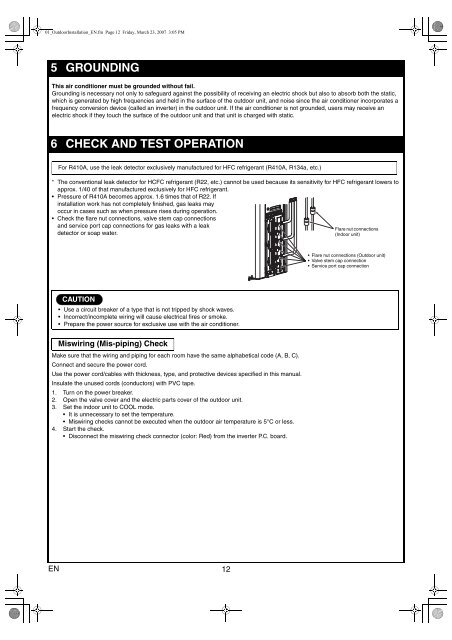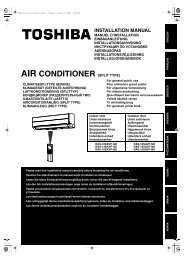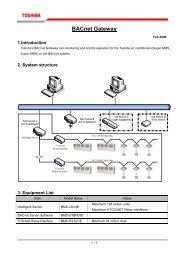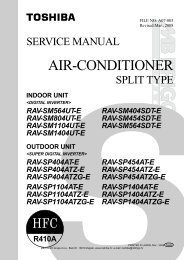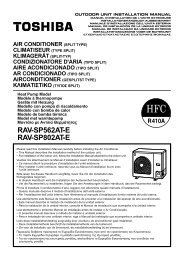air conditioner (multi-split type) outdoor unit installation manual
air conditioner (multi-split type) outdoor unit installation manual
air conditioner (multi-split type) outdoor unit installation manual
Sie wollen auch ein ePaper? Erhöhen Sie die Reichweite Ihrer Titel.
YUMPU macht aus Druck-PDFs automatisch weboptimierte ePaper, die Google liebt.
01_OutdoorInstallation_EN.fm Page 12 Friday, March 23, 2007 3:05 PM<br />
5 GROUNDING<br />
This <strong>air</strong> <strong>conditioner</strong> must be grounded without fail.<br />
Grounding is necessary not only to safeguard against the possibility of receiving an electric shock but also to absorb both the static,<br />
which is generated by high frequencies and held in the surface of the <strong>outdoor</strong> <strong>unit</strong>, and noise since the <strong>air</strong> <strong>conditioner</strong> incorporates a<br />
frequency conversion device (called an inverter) in the <strong>outdoor</strong> <strong>unit</strong>. If the <strong>air</strong> <strong>conditioner</strong> is not grounded, users may receive an<br />
electric shock if they touch the surface of the <strong>outdoor</strong> <strong>unit</strong> and that <strong>unit</strong> is charged with static.<br />
6 CHECK AND TEST OPERATION<br />
* The conventional leak detector for HCFC refrigerant (R22, etc.) cannot be used because its sensitivity for HFC refrigerant lowers to<br />
approx. 1/40 of that manufactured exclusively for HFC refrigerant.<br />
Pressure of R410A becomes approx. 1.6 times that of R22. If<br />
<strong>installation</strong> work has not completely finished, gas leaks may<br />
occur in cases such as when pressure rises during operation.<br />
Check the flare nut connections, valve stem cap connections<br />
EN<br />
For R410A, use the leak detector exclusively manufactured for HFC refrigerant (R410A, R134a, etc.)<br />
and service port cap connections for gas leaks with a leak<br />
detector or soap water.<br />
CAUTION<br />
Use a circuit breaker of a <strong>type</strong> that is not tripped by shock waves.<br />
Incorrect/incomplete wiring will cause electrical fires or smoke.<br />
Prepare the power source for exclusive use with the <strong>air</strong> <strong>conditioner</strong>.<br />
Miswiring (Mis-piping) Check<br />
Make sure that the wiring and piping for each room have the same alphabetical code (A, B, C).<br />
Connect and secure the power cord.<br />
Use the power cord/cables with thickness, <strong>type</strong>, and protective devices specified in this <strong>manual</strong>.<br />
Insulate the unused cords (conductors) with PVC tape.<br />
1. Turn on the power breaker.<br />
2. Open the valve cover and the electric parts cover of the <strong>outdoor</strong> <strong>unit</strong>.<br />
3. Set the indoor <strong>unit</strong> to COOL mode.<br />
It is unnecessary to set the temperature.<br />
Miswiring checks cannot be executed when the <strong>outdoor</strong> <strong>air</strong> temperature is 5°C or less.<br />
4. Start the check.<br />
Disconnect the miswiring check connector (color: Red) from the inverter P.C. board.<br />
12<br />
Flare nut connections<br />
(Indoor <strong>unit</strong>)<br />
Flare nut connections (Outdoor <strong>unit</strong>)<br />
Valve stem cap connection<br />
Service port cap connection


